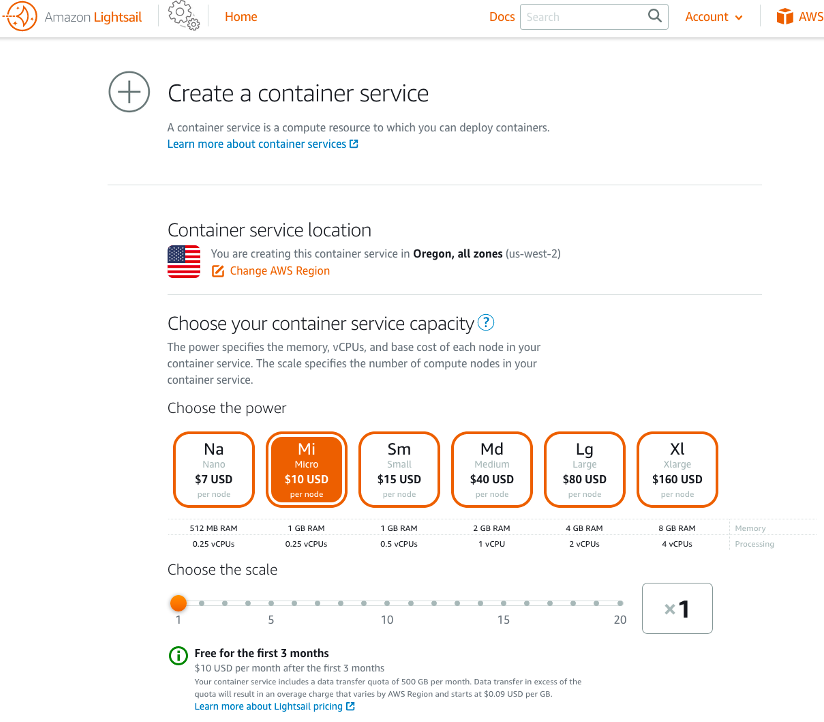AWS Compute Blog
Introducing Native Support for Predictive Scaling with Amazon EC2 Auto Scaling
This post is written by Scott Horsfield, Principal Solutions Architect, EC2 Scalability and Ankur Sethi, Sr. Product Manager, EC2 Amazon EC2 Auto Scaling allows customers to realize the elasticity benefits of AWS by automatically launching and shutting down instances to match application demand. Today, we are excited to tell you about predictive scaling. It is a […]
Monitoring memory usage in Amazon Lightsail instance
This post is written by Sebastian Lee, Solution Architect, Startup Singapore. Amazon Lightsail is a great starting point for those looking to get started on AWS. Lightsail is ideal for startups, SMBs, and hobbyist developers because it simplifies the deployment of instances, databases, load-balancers, CDNs, and even containers. However, you cannot track metrics beyond CPU […]
Frictionless hosting of containerized ASP.NET web apps using Amazon Lightsail
This post is written by Fahad Mustafa, Cloud Application Architect, AWS Professional Services There are many ways to deploy ASP.NET web apps to AWS. Each with its own use cases and differing pricing models. But what if you have a small website and database that you must deploy rapidly, manage, and scale? What if you […]
Using the EC2 Serial Console to access the Microsoft Server boot manager to fix and debug boot failures
This post is written by Pallavi Ravishankar a Senior Product Manager and Jason Nicholls an Enterprise Solutions Architect. Failure management is a key part of the reliability pillar within the AWS Well-Architected Framework. But things fail, and operating systems are no exception. An operating system update, application update, a misconfiguration, missing driver, or incorrect security […]
Using EC2 Serial Console to access the GRUB menu and recover from boot failures
This post is written by Pallavi Ravishankar a Senior Product Manager and Jason Nicholls an Enterprise Solutions Architect. Debugging and fixing infrastructure is one of the key responsibilities of system and network administrators. When an instance fails to start up on premises or can no longer connect to the network, an administrator can walk up […]
Architecting for DR on AWS Outposts with CloudEndure
This post is written by Scott Howe – Sr. Secure Hybrid Edge Solutions Architect and Schneider Larbi – Sr. Partner Solutions Architect (VMware & Outposts) AWS Outposts is a fully managed offering that extends AWS infrastructure into your data center to facilitate workloads requiring local processing, data residency, minimal application latency, and 2-step migration journeys. Due […]
Launching a WordPress Website using Amazon Lightsail Containers
This post is written by Benjamin Gardiner, Partner Solutions Architect. Amazon Lightsail is a great way to get familiar with AWS. Lightsail simplifies the deployment of instances, databases, load balancers, CDNs, and now also containers. In this post I demonstrate how easy it is to launch a WordPress website using Lightsail containers and a Lightsail […]
Supporting AWS Graviton2 and x86 instance types in the same Auto Scaling group
This post is written by Tyler Lynch, Sr. Solutions Architect – EdTech, and Praneeth Tekula, Technical Account Manager. As customers seek performance improvements and to cost optimize their workloads, they are evaluating and adopting AWS Graviton2 based instances. This post provides instructions on how to configure your Amazon EC2 Auto Scaling group (ASG) to use […]
Managing domain membership of dynamic fleet of EC2 instances
This post is written by Alex Zarenin, Senior AWS Solution Architect, Microsoft Tech. Updated: February 10, 2021 1. Introduction For most companies, a move of Microsoft workloads to AWS starts with “lift and shift” where existing workloads are moved from the on-premises data centers to the cloud. These workloads may include WEB and API farms, […]
Running cost optimized Spark workloads on Kubernetes using EC2 Spot Instances
This post is written by Kinnar Sen, Senior Solutions Architect, EC2 Spot Apache Spark is an open-source, distributed processing system used for big data workloads. It provides API operations to perform multiple tasks such as streaming, extract transform load (ETL), query, machine learning (ML), and graph processing. Spark supports four different types of cluster managers (Spark standalone, Apache […]






